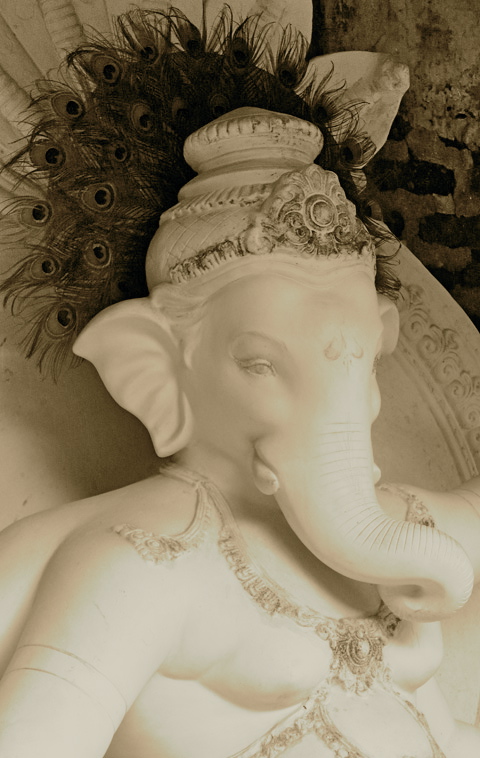

A crowd, more or less numerous, accompanies the idol, clapping hands and raises cries of joy, while a little orchestra generally precedes the idol.

Each little quarter of the town, each family with its adherents, each little street corner I may almost say, organizes a procession of its own, and the poorest may be seen carrying on a simple plank their little idol or of paper mâché. I followed with the greatest curiosity crowds who carried in procession an infinite number of idols of the God Ganesh. After the start of the British Raj, the Ganesh festival lost state patronage and became a private family celebration in Maharashtra until its revival by Indian freedom fighter and social reformer Lokmanya Tilak. The Peshwa in the 18th century were devotees of Ganesh and started as a public Ganesh festival in their capital city of Pune during the month of Bhadrapad. Festival Īlthough it is unknown when (or how) Ganesh Chaturthi was first observed, the festival has been publicly celebrated in Pune since the era of King Shivaji (1630–1680, founder of the Maratha Empire). Ganesh idol in Khairatabad, Hyderabad, Indiaįor example, carvings at Hindu, Buddhist, and Jain temples such as at the Ellora Caves, dated between the 5th and 8th-century show Ganesh reverentially seated with major Hindu goddess ( Shakti). Beyond textual interpretations, archaeological and epigraphical evidence suggest Ganesh had become popular, was revered before the 8th century CE and numerous images of him are traceable to the 7th century or earlier. The Skanda Purana, Narada Purana and the Brahma Vaivarta Purana, in particular, profusely praise him.

Ganesh appears in the medieval Puranas in the form of "god of success, obstacle remover".

appears in post-Vedic texts such as the Grhya Sutras and thereafter ancient Sanskrit texts such as the Vajasaneyi Samhita, the Yajnavalkya Smriti and the Mahabharata mention Ganapati as Ganesvaras and Vinayak. However, it is uncertain that the Vedic term Ganapati which literally means "guardian of the multitudes", referred specifically to later era Ganesh, nor do the Vedic texts mention Ganesh Chaturthi. Both of these shlokas imply a role of Ganapati as "the seer among the seers, abounding beyond measure in food presiding among the elders and being the lord of an invocation", while the shloka in mandala 10 states that without Ganapati "nothing nearby or afar is performed without you", according to Michael. It appears twice in the Rigveda, once in shloka 2.23.1, as well as in shloka 10.112.9. Though not alluding to the classical form of Ganapati, the earliest mention of Ganapati is found in the Rigveda. Īt public venues, along with the reading of texts and group feasting, athletic and martial arts competitions are also held. In the Gregorian calendar, Ganesh Chaturthi falls between 22 August and 20 September every year. Ganesh Chaturthi is also observed in Nepal and by the Hindu diaspora elsewhere such as in Australia, New Zealand, Canada, Singapore, Malaysia, Trinidad and Tobago, Guyana, Suriname, other parts of the Caribbean, Fiji, Mauritius, South Africa, United States, and Europe. The festival celebrates Lord Ganesh as the God of New Beginnings and the Remover of Obstacles as well as the god of wisdom and intelligence and is observed throughout India, especially in the states such as Maharashtra and Goa. Thereafter the clay idol dissolves and Ganesh is believed to return to Mount Kailash to Parvati and Shiva. In Mumbai alone, around 150,000 statues are immersed annually. The festival ends on the tenth day after start, when the idol is carried in a public procession with music and group chanting, then immersed in a nearby body of water such as a river or sea, called visarjan. Offerings and prasāda from the daily prayers, that are distributed from the pandal to the community, include sweets such as modaka as it is believed to be a favourite of Lord Ganesh. Observations include chanting of Vedic hymns and Hindu texts such as, prayers and vrata (fasting). The festival is marked with the installation of Lord Ganesh's clay murtis privately in homes and publicly by Shri Bal Gangadhar Tilak popularly known as Lokmanya Tilak in Pune in the year 1893 on elaborate pandals (temporary stages). Ganesh Chaturthi ( ISO: Gaṇeśa Caturthī), also known as Vinayaka Chaturthi ( Vināyaka Caturthī), or Vinayaka Chaviti ( Vināyaka Cavitī) is a Hindu festival celebrating the arrival of Lord Ganesh to earth from Kailash Parvat with his mother Goddess Parvati/ Gauri.


 0 kommentar(er)
0 kommentar(er)
